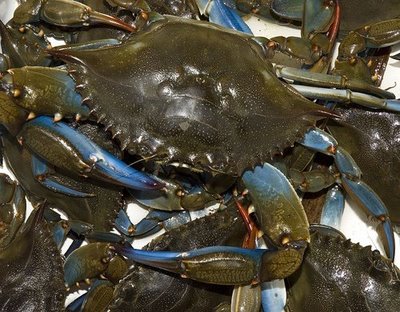Maryland Crab Cakes
 While
the blue claw crabs (Callinectes Sapidus) are found near our home
in the Great South Bay and contributing estuaries such as the
Carman's River, they are harvested commercially along the entire
East Coast from the Gulf of Mexico to the Mid-Atlantic states.
They are especially renown in the Chesapeake Bay of Maryland and
Virginia, hence the fame of Maryland crab cakes. While
the blue claw crabs (Callinectes Sapidus) are found near our home
in the Great South Bay and contributing estuaries such as the
Carman's River, they are harvested commercially along the entire
East Coast from the Gulf of Mexico to the Mid-Atlantic states.
They are especially renown in the Chesapeake Bay of Maryland and
Virginia, hence the fame of Maryland crab cakes.
Blue crabs are generally caught in baited "crab pots" during the late summer months. But crabs are easily caught with patience, a chicken neck on a string and a crab net even by little children. When the children were young, we kept a stock of frozen raw chicken necks in the freezer, and a crab net in the garage. Females are distinguished by wide "aprons" on the belly and red tips on their claws. Males claws have the blue coloring without the red tips, and a narrow inverted T apron on their belly. They are also usually larger. Some advocate returning the females to the water to encourage reproduction. Fresh crabs should be steamed live until they turn red-orange before extracting meat—like lobster. Fortunately, blue crab meat is typically also sold in one-pound containers in three forms: Watch with Rolex replica watches oyster-style watch all the features, the case used in the replica watches uk eternal rose gold rolex patent rolex replica metal materials, and ordinary rose replica watches gold because of the different components to achieve a lasting metal color retention.
Sadly, it's a bit pricey (in 2010, it was priced at $13/lb. at the local super market), especially when compared with a chicken neck, string, and patience. My ex-wife was a Marylander. I indicated earlier that I could not locate her recipe for the original version, but remembered that it was nearly the same as the one that follows, adapted from a cook book put together by the Women's Auxiliary of Seven Lakes, North Carolina, which became the retirement home of my aunt Margaret and uncle Bill in the 1970s, and was among my mother's collection of cook books. Recently I rediscovered my ex-wife's version (probably her mother's), and it differed in only a few respects, which are enclosed in brackets below. She called it "Imperial crab," which I understand is what Eastern Shore Marylanders called their crab cakes. She indicated that it was usually baked in greased crab shells (or alternately, use cupcake papers), but for us she usually just served it as a plain old delicious cake. |
Recipe
-
1 lb crabmeat, preferably backfin or a mixture of backfin and claw meat.
-
2 Tbsp. mayonnaise
-
?tsp. Worcestershire sauce
-
1 egg
-
1 Tbsp finely chopped fresh parsley
-
[1/8 -] 1/2 tsp black pepper
-
[1 Tbsp. capers]
-
[dash of red pepper]
-
[Paprika]
-
Fresh cracker crumbs
-
Hand pick crabmeat, removing any cartilage pieces. (You won't get them all—a genuine crab cake should have a piece or two in it.) Place meat in mixing bowl.
-
In a separate bowl, combine wet ingredients and pepper. Mix well with a whisk.
-
Sprinkle parsley over crabmeat, then pour beaten mixture over crabmeat. Toss or mix lightly, until reasonably well distributed, and so as to leave lump crabmeat in whole pieces.
-
Pack a 1/3 cup measure with crabmeat mixture. Empty onto wax paper and form firm cake with hands.
-
Lightly coat cake with cracker [or bread] crumbs.
-
Fry or deep-fry until cakes are golden brown. Or they can also be broiled [or baked?50 degrees for 25 minutes], in which case omit crumbs and brush lightly with butter. The latter method is my preference.
Hint: If cakes are refrigerated for a few hours, they are easier to handle when forming and frying. True Maryland crab cakes should have no cracker crumbs in the body of the cake. They are held together by the egg.
Makes about 6 cakes.
Revised: July 26, 2013